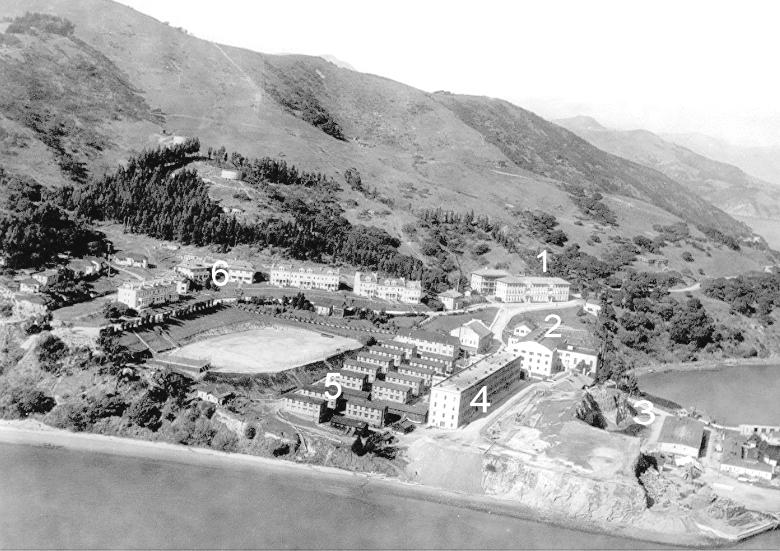
During the Spanish-American War and the subsequent Philippine Insurrection, activity grew on the island due to the post processing men on their way to and from overseas duty. A Detention Camp was established on the east side of the Island, next to the quarry, in 1899 to house returning troops who had been stricken with, or exposed to, contagious diseases. The first Army unit to occupy the camp was the 31st Volunteer Infantry, which had smallpox in its ranks.
In May of 1901 the Detention Camp was moved to Point Simpton and a Discharge Camp was erected on the quarry site. The Discharge Camp was used to process soldiers returning from the Philippines. All needed facilities were available to the returning soldiers, including a railroad ticket office and Wells Fargo Express Company office. At the Discharge Camp, the men were processed for separation from the Army, given their final pay, and mustered out of the service. In the first eight months, 11,915 soldiers were processed and by 1905, some 87,000 men had passed through the camp.

1926 view of Fort McDowell (aka East Garrison) Here the East Garrison of Fort McDowell is shown as it was prior to World War II. Shown: 1) Post Hospital, 2) Main Mess Hall, 3) quarry area, 4) the “600-Man barracks” (later known as the “1000-Man Barracks” due to the influx of soldiers it needed to house), 5)temporary enlisted men’s barracks, 6) Officers’ Row. The flat area at the lower left center is the parade ground/playing field area.
On April 4, 1900 the name of the post on Angel Island was officially changed from Camp Reynolds to Fort McDowell, in honor of General Irvin McDowell, who had served in the Mexican War, led the Union Army at the first battle of Bull Run in the Civil War, and had been the Commanding Officer of the Department of the Pacific, with headquarters at the Presidio.
In 1907 an era on Angel Island came to an end and a new one began. The post was to continue to receive recruits, provide them with initial training, and forward them to their assigned posts. In addition, all enlisted men returning from Pacific posts for discharge, furlough, retirement, or transfer were to be sent directly from the transports to Angel Island for processing. Fort McDowell was about to enter the period of its greatest activity and importance in military history.
In the summer of 1909, using military prisoners from the Army Prison on Alcatraz as labor, major building began on what had been the site of the Discharge Camp and Fort McDowell expanded into a Recruit Depot. In just a few years, a 600-man barracks, a new Hospital, a Main Mess hall with seating for 1400 men, officers’ quarters, a guard house, and other buildings were constructed. The post headquarters moved from Camp Reynolds to the new garrison, which became the East Garrison of Fort McDowell; the former Camp Reynolds became West Garrison.
Fort McDowell was very active during World War I, serving as a Recruit Depot for men entering the Army. In addition to enlisted men returning from Hawaii and the Philippines being processed at the post, men drafted in the western states were now sent to Fort McDowell. About 4,000 men per month passed through Fort McDowell during this period. Following World War I, military activity declined and Fort McDowell became the Overseas Discharge and Replacement Depot in 1922. In this capacity it handled men leaving for, and returning from, overseas posts.
When World War II began, Fort McDowell became part of the San Francisco Port of Embarkation, together with Fort Mason, the Oakland Army Terminal, and Camp Stoneman. This began the busiest period in the Fort’s history. More than 300,000 soldiers were shipped to the Pacific Theater of Operations through Fort McDowell.
The busiest period for the post occurred, however, when the war ended – 23,632 returning men were processed during December, 1945, the busiest month in the post’s history. In that same month, the Main Mess Hall served 310,323 meals, including 3.5 tons of turkey for Christmas dinner, a record. With the war over, military action began to diminish, and the reorganization of the San Francisco Port of Embarkation did not include Fort McDowell. No longer needed by the Army, the flag was lowered for the last time at the post on August 28, 1946.
Images of America; Angel Island
Miwoks to Missiles
Our Community. Our Island. Our Legacy.
Angel Island Conservancy// PO Box 866 / Tiburon / CA 94920// info@angelisland.org// Tax ID No. 51-0152954// FACEBOOK// FLICKR// INSTAGRAM